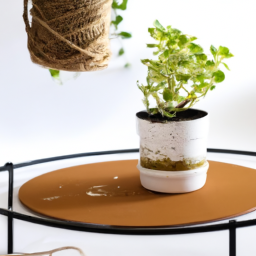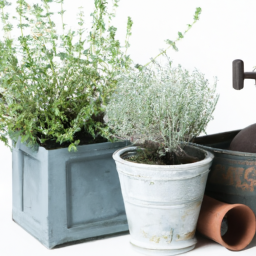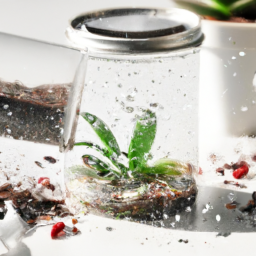
Hey there plant lovers! Are you looking for a fun and creative way to bring a little bit of nature into your home? Well, look no further because today we’re diving into the world of plant terrarium DIY: crafting mini ecosystems. Whether you have a green thumb or are just starting out on your gardening journey, creating your own plant terrarium is a fantastic way to add a touch of greenery to any space. So, grab your gardening gloves and let’s get started on this exciting and rewarding project!
The Basics of Creating a Plant Terrarium: Step-by-Step Guide
Introduction
Creating a plant terrarium is not only a fun and rewarding DIY project but also a great way to bring a piece of nature into your home. Terrariums are mini ecosystems that require minimal maintenance and can be a beautiful addition to any space. In this step-by-step guide, we will walk you through the process of creating your own plant terrarium, from selecting the right container to choosing the perfect plants and maintaining your mini garden.
Choosing the Right Container
The first step in creating a plant terrarium is selecting the right container. You can choose from a variety of options such as glass jars, fish tanks, or even repurposed glass containers. The key is to ensure that the container has a lid or can be covered to create a closed environment. This will help maintain the humidity levels required for the plants to thrive.
When choosing the size of your container, consider the space available in your home and the number of plants you want to include. A larger container will allow for more diversity in plant selection and will be easier to maintain in terms of watering and pruning.
Preparing the Container
Once you have chosen your container, it’s time to prepare it for your mini ecosystem. Start by cleaning the container thoroughly to remove any dirt or residue. You can use warm soapy water and a soft cloth or sponge for this.
Next, add a layer of drainage material at the bottom of the container. This can be small stones, pebbles, or even activated charcoal. The drainage layer will prevent water from accumulating at the bottom and causing root rot.
Choosing the Right Plants
Now comes the exciting part – choosing the plants for your terrarium. When selecting plants, it’s important to consider their compatibility in terms of light and humidity requirements. Opt for plants that thrive in similar conditions to ensure they will coexist harmoniously within the closed environment of the terrarium.
Some popular plant choices for terrariums include ferns, mosses, succulents, and air plants. These plants are known for their ability to thrive in humid and low-light conditions. Be sure to research each plant’s specific care needs before making your final selection.
Planting and Arranging
Once you have chosen your plants, it’s time to plant and arrange them in your terrarium. Start by adding a layer of potting soil on top of the drainage layer. This will provide the plants with the necessary nutrients to grow.
Gently remove the plants from their pots, being careful not to damage the roots, and place them in the terrarium. Arrange them in a way that allows each plant to have enough space to grow and spread its foliage.
After planting, give your terrarium a good watering. Be careful not to overwater, as this can lead to root rot. The soil should be slightly moist but not saturated.
Maintenance and Care
Maintaining your plant terrarium is relatively easy, but it does require some regular care. Here are a few tips to keep your mini ecosystem thriving:
1. Light: Place your terrarium in an area with indirect sunlight or artificial light. Avoid placing it in direct sunlight, as this can cause the temperature inside the terrarium to rise, leading to plant damage.
2. Watering: Monitor the moisture levels in your terrarium and water only when the soil feels dry to the touch. Use a spray bottle to mist the plants and the inside of the container. Avoid overwatering, as it can lead to fungal growth and root rot.
3. Pruning: Regularly trim any dead or yellowing leaves to maintain the overall health and appearance of your plants. Overgrown plants can also be pruned to control their size and shape.
4. Cleaning: Keep the glass walls of your terrarium clean by wiping them with a soft cloth or sponge. This will allow maximum light penetration and keep your mini ecosystem looking its best.
Conclusion
Creating a plant terrarium is a wonderful way to bring a touch of nature into your home. By following this step-by-step guide, you can craft your own mini ecosystem and enjoy the beauty and tranquility it brings. Remember to choose the right container, select compatible plants, and provide the necessary care to keep your terrarium thriving. So, roll up your sleeves, get creative, and embark on this rewarding DIY journey to create your very own plant terrarium!
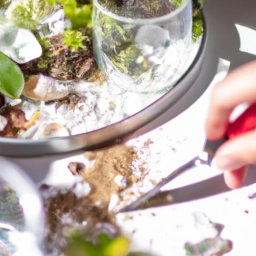
Choosing the Right Plants for Your DIY Plant Terrarium
Creating your own plant terrarium is an exciting and rewarding project that allows you to bring a piece of nature into your home. One of the most important aspects of building a successful terrarium is choosing the right plants. In this guide, we will walk you through the process of selecting the perfect plants for your mini ecosystem.
Understanding Terrarium Types
Before diving into plant selection, it’s crucial to understand the different types of terrariums. There are two main categories: open and closed terrariums. Open terrariums have better airflow and are suitable for plants that prefer drier conditions, while closed terrariums create a more humid environment, perfect for moisture-loving plants.
If you opt for an open terrarium, consider plants such as succulents, cacti, and air plants. These plants thrive in arid conditions and require minimal watering. On the other hand, closed terrariums are ideal for ferns, mosses, and tropical plants that enjoy a high level of humidity.
Assessing Light Requirements
Light is a crucial factor in plant growth, and it’s essential to choose plants that will thrive in the available light conditions of your home. Before selecting plants, assess the lighting in the area where your terrarium will be placed. Is it bright and sunny, or does it receive only indirect light?
If your terrarium will be exposed to direct sunlight, opt for plants that can tolerate bright light, such as succulents and cacti. These plants have adapted to thrive in desert-like conditions and can handle intense sunlight. However, if your terrarium will be situated in a spot with indirect light, consider shade-loving plants like ferns and ivy.
Considering Plant Size and Growth
When choosing plants for your terrarium, it’s essential to consider their mature size and growth rate. You want to ensure that the plants you select will fit within the confines of your terrarium and won’t outgrow the space too quickly.
For smaller terrariums, opt for miniature plants or those with slow growth rates. Some great options include baby’s tears, mosses, and small fern varieties. These plants will maintain a compact size and won’t overcrowd your terrarium. If you have a larger terrarium, you have more flexibility and can choose plants with faster growth rates, such as pothos or spider plants.
It’s also crucial to consider the compatibility of the plants you choose. Ensure that they have similar light and water requirements to create a harmonious ecosystem within your terrarium.
Conclusion
Choosing the right plants for your DIY plant terrarium is a crucial step in creating a thriving mini ecosystem. Consider the type of terrarium, the lighting conditions, and the size and growth rate of the plants you select. By carefully assessing these factors, you can create a beautiful and balanced terrarium that will bring joy and a touch of nature into your home.
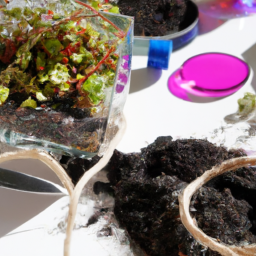
3. Tips and Tricks for Maintaining a Healthy Mini Ecosystem in Your Plant Terrarium
Plant terrariums are not only beautiful but also serve as mini ecosystems that can thrive in your home or office. These self-contained environments create a perfect balance of moisture, light, and air for the plants inside. However, maintaining a healthy mini ecosystem requires some care and attention. In this article, we will provide you with some tips and tricks to ensure your plant terrarium remains vibrant and flourishing.
Choosing the Right Plants
When it comes to creating a mini ecosystem in your plant terrarium, selecting the right plants is crucial. Opt for plants that are well-suited for terrarium conditions, such as those that thrive in high humidity and low light. Some popular choices include ferns, mosses, succulents, and air plants. These plants have adapted to survive in enclosed spaces and can withstand the conditions within a terrarium.
It’s important to consider the size of your terrarium when choosing plants. Select plants that are proportionate to the container, ensuring they have enough space to grow without overcrowding. Additionally, choose plants with similar care requirements, so you can provide them with the necessary conditions for optimal growth.
Before adding the plants to your terrarium, make sure to inspect them for any signs of pests or diseases. Introducing infected plants can harm the entire ecosystem, so it’s essential to start with healthy specimens. Remove any dead or yellowing leaves and gently clean the plants to remove any dust or debris.
Proper Watering Techniques
Watering is a critical aspect of maintaining a healthy mini ecosystem in your plant terrarium. Overwatering can lead to root rot and the growth of mold or fungus, while underwatering can cause the plants to wither and die. Finding the right balance is key.
One effective technique is to observe the moisture levels in the terrarium. If the soil appears dry, it’s time to water the plants. Use a spray bottle or a small watering can with a narrow spout to ensure controlled watering. Avoid over-saturating the soil by providing just enough water to moisten it without creating standing water.
Another important factor to consider is the type of water you use. Tap water may contain chemicals, such as chlorine or fluoride, which can harm the plants. It’s best to use filtered or distilled water to prevent any potential damage. Additionally, make sure the water is at room temperature, as extreme temperatures can shock the plants.
Remember to monitor the moisture levels regularly and adjust your watering schedule accordingly. Each terrarium is unique, so it may take some trial and error to determine the ideal watering frequency for your specific ecosystem.
Providing Adequate Light
Light is a vital component for the photosynthesis process, which allows plants to convert light energy into food. When it comes to mini ecosystems in plant terrariums, finding the right balance of light is crucial for the plants’ health and growth.
Place your terrarium in a location that receives indirect or filtered light. Direct sunlight can cause excessive heat and damage the plants, while complete darkness can hinder their growth. A bright room with ample natural light, such as near a north or east-facing window, is generally ideal for most terrarium plants.
If your terrarium is not getting enough light, you can supplement it with artificial light sources. LED grow lights are a popular choice as they provide the necessary spectrum of light for plant growth while consuming less energy. Position the lights a few inches above the terrarium, ensuring they are not too close to avoid overheating the plants.
Keep in mind that different plants have varying light requirements. Some plants, like succulents, prefer brighter light, while others, like ferns, thrive in lower light conditions. Research the specific light needs of the plants in your terrarium to provide them with the optimal environment.
By following these tips and tricks, you can maintain a healthy mini ecosystem in your plant terrarium. Remember to choose the right plants, water them properly, and provide adequate light. With a little care and attention, your terrarium will flourish, bringing a touch of nature and beauty to your space.
Key Takeaways of this article
Are you looking for a fun and creative way to bring some greenery into your home? Look no further than plant terrariums! These mini ecosystems are not only visually appealing but also incredibly easy to make. In this blog post, we will guide you through the process of crafting your own plant terrarium, step by step.
To start, you’ll need a few basic materials: a glass container, some pebbles or rocks, activated charcoal, potting soil, and of course, your choice of plants. The glass container can be anything from a mason jar to a fishbowl, as long as it has a lid or can be covered. Once you have your materials ready, it’s time to assemble your mini ecosystem. Begin by adding a layer of pebbles or rocks at the bottom of the container. This will help with drainage and prevent water from pooling at the roots of your plants. Next, sprinkle a thin layer of activated charcoal on top of the rocks. The charcoal will help keep the terrarium fresh by absorbing any odors or impurities. Now it’s time to add the potting soil, making sure to leave enough space for your plants to grow. Finally, carefully plant your chosen greenery, arranging them in a way that pleases your eye. Remember to choose plants that have similar care requirements and will thrive in the conditions of your home. Once your terrarium is complete, give it a thorough watering and place the lid on top to create a humid environment for your plants. Find a spot with indirect sunlight, and voila! You’ve just created your very own plant terrarium. These mini ecosystems are not only a beautiful addition to any home decor but also require minimal maintenance, making them perfect for those with a busy lifestyle. So why not give it a try? Start crafting your plant terrarium today and enjoy the benefits of bringing nature indoors.
Frequently Asked Questions from our readers:
Q1: What is a plant terrarium?
A1: A plant terrarium is a miniature glass container that houses a small ecosystem of plants. It is designed to mimic the conditions required for plants to thrive, creating a self-sustaining environment.
Q2: How do I make a plant terrarium?
A2: Making a plant terrarium is fairly simple. First, choose a glass container with a lid. Then, add a layer of gravel or small rocks at the bottom for drainage. Next, add a layer of activated charcoal to keep the terrarium fresh. After that, add a layer of potting soil and arrange your chosen plants inside. Finally, water the terrarium lightly and close the lid to create a humid environment.
Q3: What plants are suitable for a plant terrarium?
A3: Several types of plants thrive in terrariums. Some popular choices are ferns, mosses, succulents, and air plants. These plants are generally low-maintenance and can adapt well to the enclosed environment of a terrarium.
Q4: How do I care for a plant terrarium?
A4: Caring for a plant terrarium involves minimal effort. Keep the terrarium in indirect sunlight, as direct sunlight can cause excessive heat and damage the plants. Water the terrarium sparingly, only when the soil feels dry to the touch. If condensation builds up on the glass, remove the lid temporarily to allow air circulation. Trim any overgrown plants to maintain the desired size and shape of your terrarium.
Q5: Can I customize my plant terrarium?
A5: Absolutely! Plant terrariums offer endless opportunities for customization. You can choose different types of plants, add decorative elements like miniature figurines or stones, or even experiment with different container shapes and sizes. Let your creativity run wild and create a unique mini ecosystem that reflects your personal style.

Lisa Chen is a seasoned indoor gardening expert and the author of several bestselling books on the topic. With a background in horticulture and urban farming, Lisa is dedicated to helping urban dwellers embrace the joys of cultivating green spaces indoors. Her detailed guides and hands-on tips empower readers to transform their living spaces into thriving plant sanctuaries.

